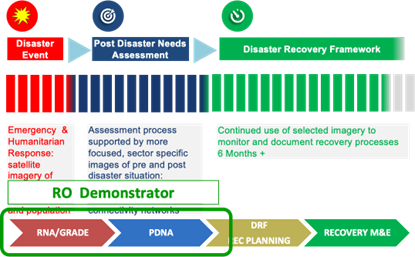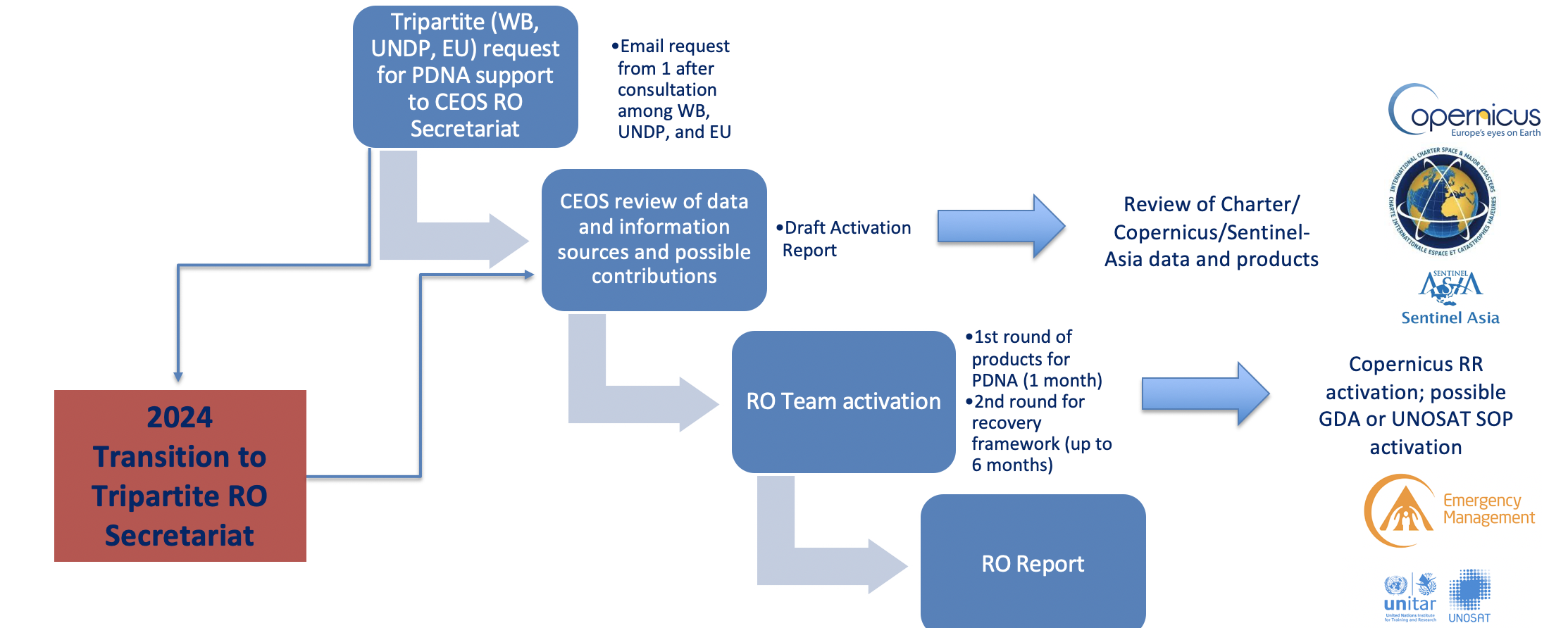The CEOS Recovery Observatory Demonstrator (RO Demo) was approved by the CEOS Plenary in November 2020. It built on the four-year experience of the RO Pilot created following Hurricane Matthew in Haiti in late 2016. That experience led to the drafting of an advocacy paper (https://www.gfdrr.org/sites/default/files/publication/Use_of_EO_Satellites_012322020_D_LOW-RES.pdf ) on the use of satellites for recovery, and the creation of the current Demonstrator.
The RO Demonstrator achieved its primary objectives, delivering a use and utility report that evaluated the timely contribution of Earth Observation (EO) data to Recovery across various scales. The RO Demonstrator provided unique data contributions to Post-Disaster Needs Assessments (PDNAs) in collaboration with the Tripartite Agreement Partners (United Nations Development Programme (UNDP), the European Union (EU), and the World Bank), facilitating effective reconstruction and rehabilitation efforts. It also played a crucial role in developing information provided in Global Rapid-post-disaster Damage Estimation (GRADE) approaches, alongside governments and stakeholders, aiding in determining the extent and scale of damage and losses incurred.
In the immediate aftermath of a disaster, satellite-based Earth Observations (EO) are increasingly used to estimate impact. Grading maps are produced to show damage and to support the response and early recovery process.
Focusing on response, governments have come together in partnership to act more efficiently through mechanisms such as the International Charter Space and Major Disasters (Charter), Sentinel-Asia and the Copernicus Emergency Management Service (EMS). After the initial response to the crisis however, much of the satellite data acquired is no longer available for distribution, and new data are not programmed for collection.
In order to facilitate access to data for recovery planning and monitoring, collaborative efforts with key stakeholders such as the United Nations Development Programme (UNDP), the EU Service for Foreign Policy Instruments (FPI), the World Bank/GFDRR. Such collaboration helped also underpin the execution of Post-Disaster Needs Assessments (PDNAs), under a tripartite agreement, fostering effective reconstruction and rehabilitation strategies. The RO Demo is managed by a RO Demo Team co-chaired by the French space agency CNES and the World Bank/GFDRR.
The RO Demo was activated for 6 ROs from 2020 to 2024 by PDNA Tripartite Agreement partners). To date, the RO Demo has been activated for:
- The Armenia floods in May 2024
- The Libya floods in September 2023
- The historic Pakistan floods in September 2022
- The Haiti earthquake in August 2021
- Hurricanes Eta and Iota in Central America late 2020
- The Lebanon explosion (Beirut Port) in August 2020)
The RO produced maps and performed in depth analysis at various scales:
- Mid-scale (10m) overviews of changes in land use and cover updated every 10 days for 6 months;
- High-resolution hot-zones and lifelines, infrastructure, transport, residences, camps updated every 1 to 2 months;
- Integrate essential ancillary data: terrain validation data, aerial and drone data, statistics, cartography.
Towards the pre-operational RO
In November 2023, the CEOS approved the “pre-operational RO” activity which consists of a ramp-up phase lasting 3 years with a view to a “permanent” RO from 2027.
This activity begins with a first year of transition (2024) with the RO team and its transfer of leadership to international actors in the disaster recovery phase (the partners of the tripartite agreement). Then a 2-year pre-operational RO (2025-2026) will run to ensure the transition to the permanent RO. The main objective of the 2024 activity is the mobilization of the partners of the tripartite agreement in their leadership role for the support and coordination of the two planned activations.
In order to continue such activities, whether future RO activations or the development of a permanent RO, CNES requires high-level support with direct experience working with these organizations and a solid knowledge of the use of satellites in the risk cycle. This high-level expertise will be used within the framework of very close cooperation with CNES to:
- Monitor and support the coordination of future RO activations;
- Coordinate the secretariat of the “RO Team”;
- Develop a “training document on the use of EO to support the PDNA” as well as a “governance” document for future members of the RO secretariat based on the pilots and demonstrators carried out by CNES in the CEOS framework before 2025.
In the frame of the RO’s ongoing commitment to DRR, it’s imperative to sustain the multilateral leadership of relevant organizations. This entails active involvement from entities such as CEOS, the WB GFDRR, and the EU’s Foreign Policy Instrument (EU-FPI). Through collaborative efforts, we can effectively address emerging challenges and ensure a coordinated response to disaster events.
To ensure the continuity and effectiveness of the RO, it is essential to maintain a dedicated team within CEOS. This team will play a pivotal role in providing ongoing support for the implementation of the RO activities.
Implementation of the RO activities.
While maintaining continuity in our efforts, it is key to recognise the importance of gradually transferring leadership roles to key recovery stakeholders. This transition, slated for 2025-2026, will involve organizations such as the World Bank, UNDP, and the European Union. Empowering these entities ensures a seamless transition and sustained momentum in our disaster risk reduction efforts.
Critical to the RO success is the continued availability of CEOS WGD data and Value-Adding (VA) contributions at existing levels per activation. This data serves as the foundation for informed decision-making and effective response strategies. Additionally, coordination with related CEOS pilots and demonstrators is paramount to ensure synergy across various initiatives. For instance, collaboration on projects such as the GSNL supersite for Kahmanmaras earthquake and Pakistan landslides will maximize our collective impact and enhance the resilience of vulnerable communities.
Partners, Data providers and Value-Adding providers
After three years of dedicated activity, the RO Demo community has flourished, operating with commendable efficiency in a best-effort mode. Except from its key partners CNES, the World Bank/GFDRR, UNDP and the European Union FPI, the collaboration encompasses a diverse array of data providers via the CEOS WG Disasters, including the Italian Space Agency (ASI), the French Space Agency (CNES), the Space Agency of Argentina (CONAE), the European Space Agency (ESA), the German Aerospace Center (DLR), the National Aeronautics and Space Administration (NASA), and the International Charter Space & Major Disasters. This coalition of data providers has facilitated access to crucial information, enabling swift and informed responses to the post-event recovery and rehabilitation efforts of the affected areas.
Moreover, the community extends beyond mere data provision, with a robust network of value-adding contributors enhancing the utility and effectiveness of the gathered information. Notable contributors include the Copernicus Emergency Management Service (EMS), the Belgian Geographical Institute (BGC), NASA, the Italian National Research Council (CIMA), the Luxembourg Institute of Science and Technology (LIST), the National Center for Geographic Information and Space (CNIGS), and the ICube-SERTIT service and School and Observatory of Earth Sciences (EOST) of the University of Strasbourg. Their collective efforts in value addition encompass a spectrum of expertise, ranging from advanced analytics to specialized mapping, augmenting the operational capabilities of the RO Demo community and bolstering its resilience against natural disasters.
The RO Demo concluded in late 2023 and a final PPT report was presented to the CEOS Plenary. For the 2024-2026 period, the RO has entered a “pre-operational” mode to determine the best level of effort and concept of operations to continue providing contributions to recovery beyond 2026.
More information on the RO can be obtained by contacting:
Sacotte Aurelien aurelien.sacotte@cnes.fr




